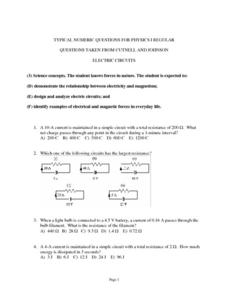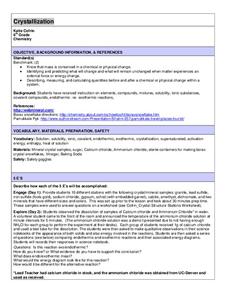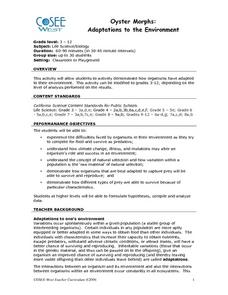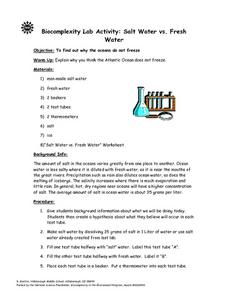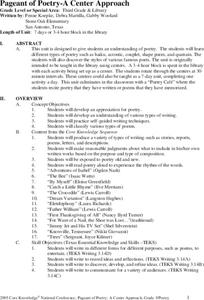Curated OER
Typical Numeric Questions for Physics I - Electric Circuits
A collection of 15 practice problems, most of them involving circuit schematics, is provided for your physics class on this handout. Learners are to compute the net charge, resistance, energy, or power dissipated for different...
Curated OER
Take Your Time
Your class examines the ways that they spend time by evaluating their own schedules. They create a peer research survey to gather information about their various habits. They analyze the data and compare/contrast the activities of...
Curated OER
Solar Heat: Building and Testing a Solar Oven
Building a solar oven is always an enriching and engaging activity when your class is studying forms of energy or alternative and renewable energy sources. This lesson plan refers you to the re-energy.ca home website for specific...
What affects Frog metamorphosis?
In this lab, students explore pollutants which affect frog metamorphosis using household pollutants (vinegar, oil, and bleach) and sponge capsules.
Curated OER
Energy and Changes of State
Students complete a variety of labs to help them explain how energy affects the changes in states of matter. They also be required to collect and record data, graph data, and apply interpretations of that data.
Curated OER
Circuit Training Surprise
Students move around the gym to music, and when the music stops, they sit on a balloon. Inside each balloon are directions for another physical activity students should do.
Berkeley Engineering and Mentors
Marshmallow Challenge
Here is a instructional activity in collaboration cleverly disguised as an engineering design activity. There is no background material for you to teach here, just instructions about materials and rules for participating groups. Use...
Curated OER
Solar Matters II- Ice Cube Race
Students discuss the methods of energy transfer. In this energy transfer lesson, students use ice to demonstrate what happens when energy is transferred. Students complete a Science Journal page as an assessment.
Curated OER
Telling Time Worksheet: What Time Is It?
In this telling time worksheet, students look at each clock and write the correct time on the line below it. There are 9 clocks on this page.
Curated OER
Paper Parachutes
Students participate in a simulation of a parachute-jump competition by making paper parachutes and then dropping them towards a target on the floor. They measure the distance from the point where the paper parachute lands compared to...
Curated OER
Picture-Go-Round
Students demonstrate how to participate in a cooperative group. In this philanthropy lesson, students create drawings by working together as a group and contributing their thoughts and feelings.
Curated OER
To The Clock of Eras
Third graders investigate the events of geological time using a chart called a "Clock of Eras". In this geological events lesson plan, 3rd graders compare a standard clock to a geological clock. In addition, students consider periods...
Curated OER
How Does Speed Change?
In this speed worksheet, students use a graph that shows various speeds to answer 13 questions. For example. "What is the greatest speed the worm reaches?"
Curated OER
The Martian Dust Devils
In this martian dust devils instructional activity, students use images of a dust devil captured by NASA's Spirit rover to calculate the distance the dust devil traveled, the speed, and its acceleration or deceleration.
Curated OER
Mapping The Ocean Floor
Young scholars explore and analyze the bottom structure of underwater habitats. They describe and explain what can't see through the collection and correlation of accurate data. Learners assess that technology is utilized as a tool for...
Curated OER
Crystallization
Eighth graders analyze physical change in mass. For this chemistry lesson, 8th graders describe, measure and calculate the amount of physical change occurring in mass before and after the change. Students should be familiar with...
Curated OER
Digital time
For this clock worksheet, students write the digital time for the hands on the clock that is given. Students complete 6 clock problems.
Curated OER
Data Corruption by High-Energy Particles
In this data corruption by high-energy particles, learners solve 4 problems about the solar flare that corrupted the imagers measuring them. Students find the speed of the arriving particles and the percentage of light-speed the...
Curated OER
Oyster Morphs: Adaptations to the Environment
Students demonstrate how organisms adapt to their environment. They examine prey and predators, natural selection, and adaptations by representing oyster morph.
Curated OER
What's Your Angle?
Third graders read the story, Magic Schoolbus Inside the Human Body. Then they form right, acute, and obtuse angles using the joints inside their bodies. They write a brief summary about what they learned about angles as a review the...
Curated OER
Salt Water vs. Fresh Water
Students explore why the oceans do not freeze. They explain why they think the Atlantic Ocean does not freeze. Students are given background information about what they are doing. They create a hypothesis about what they believe...
Curated OER
A Center Approach to Poetry
Students experience the different types of poetry in order to classify them. In this poetry lesson, students discover the multiple types of poetry while reading in the library. Ultimately, the students create their own poetry and share...
Micron Technology Foundation
Forces of Motion: Rockets
Young scientists design a rocket to launch using Newton's Laws of Motion in order to discover for themselves the forces of motion.
Pennsylvania Department of Education
Build What I've Created
n this geometric lesson, students define and identify two dimensional shapes based on their attributes. They complete worksheets based on the geometric concepts.


